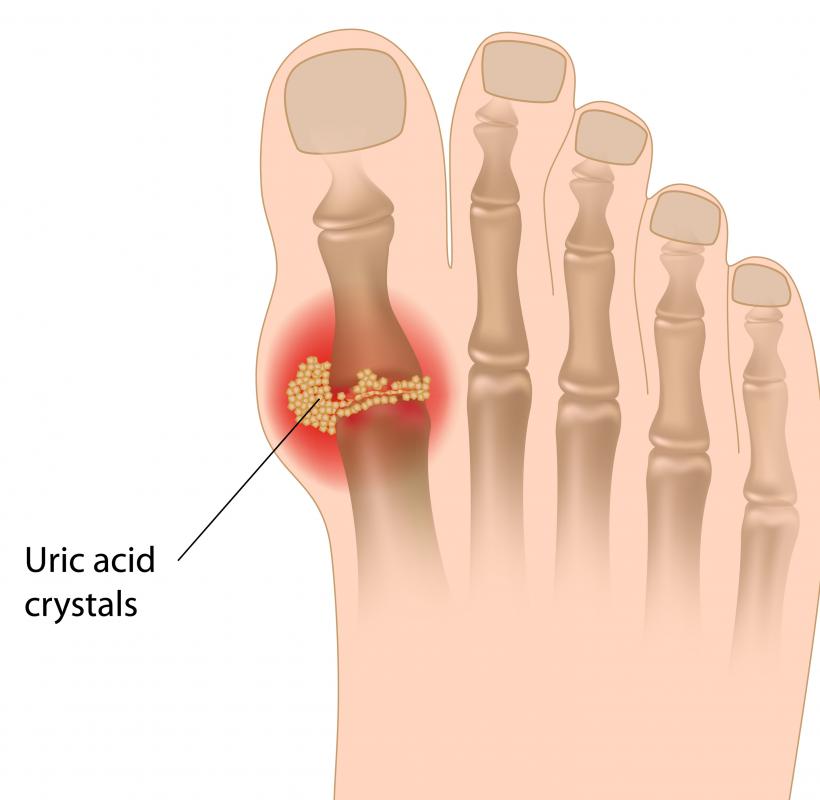At WiseGEEK, we're committed to delivering accurate, trustworthy information. Our expert-authored content is rigorously fact-checked and sourced from credible authorities. Discover how we uphold the highest standards in providing you with reliable knowledge.
What is a Gout Attack?
A sudden episode of severe, arthritic joint pain triggered by the presence of uric acid accumulation, in the form of urate crystals, is known as a gout attack. Often presenting in the lower limbs and digits, gout may affect anyone of any age at any time. Treatment for this condition is often centered on symptom management and preventing future gout attacks with the administration of analgesics and medications to reduce inflammation and discomfort, such as corticosteroids. Moderate to severe cases may necessitate the use of medications to inhibit one’s uric acid production and promote urination to expel excess metabolized acid from his or her system.
Uric acid is naturally produced in the body, metabolized in the blood and expelled from the body as waste in urine. The essential acid serves to metabolize purines, which are naturally found in the body and many foods, aiding with maintaining system balance and digestion. In the presence of excessive amounts of uric acid the kidneys are unable to compensate for the excess and may even decrease their output resulting in the buildup of uric acid in the body. Excess acid eventually solidifies to form urate crystals within the joints, causing pronounced discomfort and inflammation.

Gout generally manifests in individuals who have a familial history of the disorder and those whose lifestyle, such as regular, excessive alcohol consumption, may increase their risk for gout attack. Individuals who regularly take diuretic medications may also possess an increased risk for becoming symptomatic. Additional factors that can affect gout development include age and the presence of certain medical conditions that affect circulation.

Following an initial consultation and physical examination, a diagnosis of gout may be made through the administration of a variety of diagnostic tests. Individuals frequently undergo a joint fluid analysis test, which involves the extraction of a minimal amount of fluid from the affected joint that is then evaluated for the presence of urate crystals. Imaging tests, including X-ray, may be administered to assess the condition and functionality of the affected area. Additionally, a battery of blood tests and a urinalysis may be performed to evaluate levels of uric acid in the individual’s system.

Individuals with this condition may experience a variety of signs and symptoms associated with an episodic gout attack. The episodes are frequently sudden and intense in their onset and may affect more than one joint. Usually manifesting in the lower extremities, a gout attack will usually occur during the nighttime hours, manifesting in one’s big toe, ankle, or wrist joint. The affected area often appears swollen and inflamed and the lightest touch can cause excruciating pain. Some individuals may also develop a fever and experience residual discomfort following the gout attack, which may last up to 24 hours.

Treatment for a gout attack generally involves the administration of medication to alleviate inflammation and discomfort and prevent future attacks. The most common treatment involves the administration of over-the-counter (OTC), nonsteroidal anti-inflammatory drugs (NSAIDs) to manage gout symptoms and reduce one’s risk for future episodes. In some cases, corticosteroids may be given to reduce moderate to severe inflammation. Those who are subject to more frequent gout attacks may be given medication, such as allopurinol, to reduce uric acid production and promote the expulsion of metabolized uric acid from the body. Additionally, dietary and lifestyle changes may be recommended to prevent future gout attacks, including limiting one’s consumption of fatty foods, losing weight, and getting appropriate, regular exercise.
AS FEATURED ON:
AS FEATURED ON:

















Discuss this Article
Post your comments